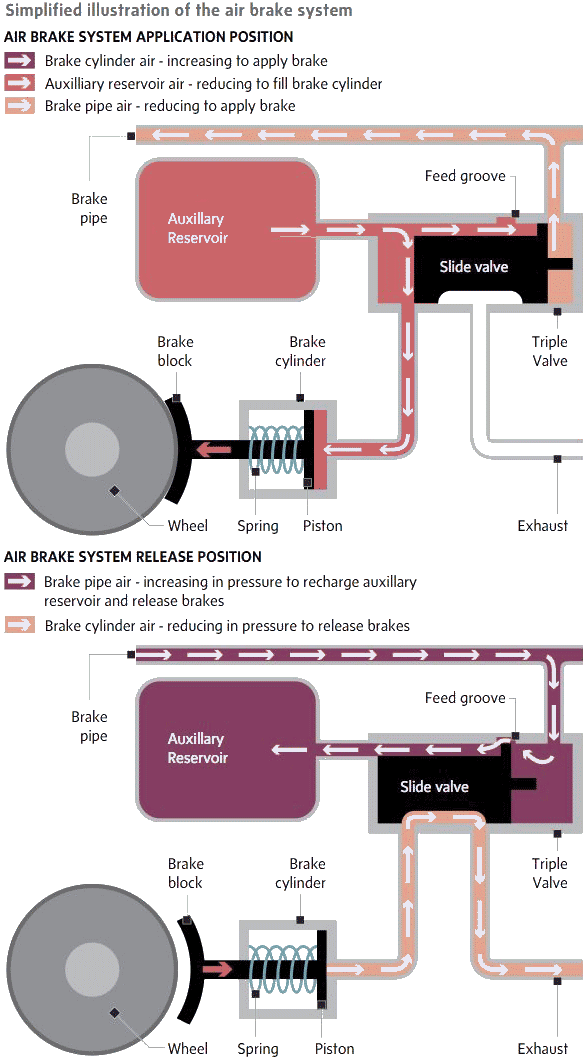
Kicking Horse River British Columbia - The investigation into a fatal train derailment along a treacherous stretch of track on the eastern
edge of B.C. will focus in part on the use of air brakes, which experts say are inherently risky when used for long periods of time in cold weather on a steep
grade.
Air brakes, such as those used to secure the Canadian Pacific Railway Ltd. (CP) train before it derailed on a B.C. mountainside Monday, killing all three crew
members, can lose air pressure and effectiveness the longer they are set in emergency mode, experts say.
The Transportation Safety Board of Canada (TSB) said handbrakes, which do not use a train's air system, were not applied before the train began rolling on its
own after making an emergency stop.
The train that derailed near the community of Field comprised 112 grain cars and three locomotives.
The train stopped short on one of the steepest and most challenging rail terrains in North America for an unscheduled crew change, it sat pointed downhill for
nearly two hours before it started moving unexpectedly.
While air brakes have been used on trains for more than a century-and-a-half with few changes, there are drawbacks to the technology.
If crews want to use air brakes after they have been set in emergency mode, the brakes need to be released and the air system recharged, said Ron Kaminkow, the
general secretary of Railroad Workers United and a long-time locomotive engineer.
The procedure can last several minutes, especially on longer trains in colder temperatures.
Mr. Kaminkow warned that railways operating longer and heavier trains in cold weather, especially in difficult mountain areas, are exposing their crews to more
risks, including those posed by air brakes.
"Long and heavy trains are problematic and dangerous, especially in the winter, especially in heavy mountain territory, especially when they have toxic or
hazardous materials," he said in an interview.
While he could not comment on the derailment near Field, Mr. Kaminkow said that in his experience, air brakes lose their power the longer they are set in
emergency mode.
He could not say how long it would take the system to lose enough air for a train to begin moving.
"Air brakes bleed off with time, and they bleed off at different rates based on the age of the equipment, the length of the train, and the ambient air
temperature," he said.
Brake cylinders with worse seals would bleed air more quickly, which could be made worse by cold temperatures and age.
To increase the effectiveness of the air system, which requires locomotives to pump air to each of the rail cars, CP placed a locomotive in the front, middle,
and back of the train, a system known as distributed power.
"Air brakes are a weird system that has worked for a long, long, time. It's been quite reliable. But what the railways have done is put longer and longer
trains, and they've tried to compensate with distributed power," said Ian Naish, a former director of rail investigations with the TSB.
"There has to be a risk with a longer train that when something goes wrong, it'll go wrong in the worst way. It's mitigated a bit by distributed power,
but it's a tougher train to handle."
In 2006, a Canadian National Railway Co. (CN) freight train loaded with lumber near Lillooet, B.C., derailed after travelling out of control down a steep
grade.
Two of the train's crew members were killed and the third suffered serious injuries.
A TSB investigation found that the train's air brakes were not sufficient to stop the load and CN's decision to forgo the use of locomotives equipped with an
additional system known as dynamic brakes could have contributed to the accident.
At the time, the board warned that brake shoes designed to older specifications might be insufficient for more modern, heavier cars.
It's still not known whether all the locomotives in the Field derailment were equipped with a dynamic braking system.
Justin Giovannetti.
OKthePK Joint Bar Editor: Typical locomotives used by CP each have 3 braking systems, the Independent, Automatic, and Dynamic
brake.
1. Independent brakes operate only on the locomotive wheels.
2. Automatic brakes are the air brakes referred to in this article. Brake reservoirs, valves, cylinders, and brake blocks are installed on each car within a
train. Air pressure to the brake pipe, which feeds all cars in a train, is supplied by air compressors on each locomotive.
3. North American locomotives are typically diesel-electric powered. A diesel engine drives an alternator or generator which produces electricity to power
electric motors on the axles of the locomotive. These motors are actually motor/generators, in other words, they can be either a motor or a generator. Placing
a locomotive in dynamic braking mode switches the motors into generators. The momentum of the locomotive then turns the motor/generators (there can be several
on various axles) which produces electricity which is fed to resistors in the roof and dissipated as heat thereby effecting a load on the motor/generator
creating a braking effect. The amount of braking applied may be controlled by the engineer in a range of 1 (least amount of braking) to 8 (the most amount of
braking). On steep mountain grades both dynamic braking and automatic braking would normally be used. Either system alone may not be sufficient to control the
rate of descent.
provisions in Section 29 of the Canadian
Copyright Modernization Act.

